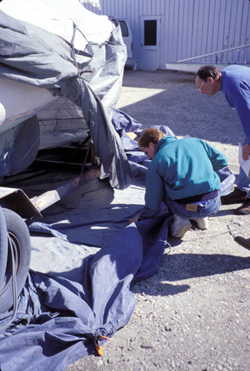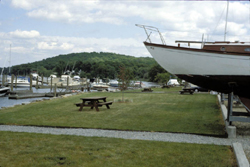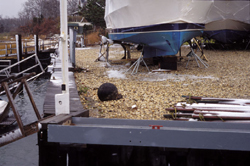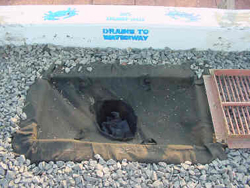New York Sea Grant's
Marina Pollution Prevention Web Site
Section 5: Facility
Management
- Stormwater Runoff Management Practices
Potential
Environmental Impacts
Stormwater runoff from parking lots and other developed surfaces
represents a significant mode of pollutant transport from land-based
activities to receiving waterbodies. The runoff from parking areas,
buildings, repair yards, and access roads can carry nutrients,
metals, suspended solids, hydrocarbons and other  potential pollutants
into marina basins. The highest concentration of these surface
pollutants occurs in the runoff associated with the first half
to one inch of rainfall depending on storm intensity. Stormwater
that is treated in some way to remove pollutants before it reaches
the marina basin minimizes impact to aquatic and marine life.
potential pollutants
into marina basins. The highest concentration of these surface
pollutants occurs in the runoff associated with the first half
to one inch of rainfall depending on storm intensity. Stormwater
that is treated in some way to remove pollutants before it reaches
the marina basin minimizes impact to aquatic and marine life.
Properly managing
storm water can be an involved process. More detailed information
on BMP siting planning, selection and design can be found by clicking
on the Related Resources and Information Button at the bottom
of this page. Your regional state environmental protection agency,
Natural Resources
Conservation Service, County Soil and Water Conservation District,
or Sea Grant office can also provide additional information and
assistance on storm water BMP planning and design
Non-structural
Best Management Practices, "Good Housekeeping" Practices:
Perform as
much boat repair and maintenance as practicable inside work buildings.
Where an inside
workspace is not available, perform abrasive blasting and sanding
within spray booths or tarp enclosures.
Where buildings
or enclosed areas are not available, provide clearly designated
land areas as far from the water's edge as possible for debris-producing
maintenance. Collect as much maintenance debris on tarps, filter
fabric, or paved surface.
 Use
vacuum sanders to collect dust and chips while removing paint
from hulls. For manufacturers of dustless vacuum sander equipment,
click here.
Use
vacuum sanders to collect dust and chips while removing paint
from hulls. For manufacturers of dustless vacuum sander equipment,
click here.
Establish
a list of "yard rules" which do-it-yourselfers and contractors
must follow when performing debris-producing boat maintenance.
Clean hull
maintenance areas immediately after any maintenance is done to
remove debris, and dispose of collected material properly.
Capture pollutants
out of runoff water with permeable tarps, screens, and filter
cloths.
Sweep or vacuum
around hull maintenance areas, parking lots, and driveways frequently,
where appropriate.
Store all
potential pollutants such as pesticides, used oil containers,
detergents, etc. under cover.
Structural
Best Management Practices
Plant a vegetated
filter strip or buffer between impervious areas and the marina
basin. A vegetated filter strip is a densely vegetated strip of
land engineered to accept runoff from upstream development as
overland sheet flow. Designed properly, a filter strip can provide
a recreational amenity for your customers and enhance the appeal
of your facility. For more information on filter strips, click
here.
 Minimize
impervious areas on marina site by paving only where absolutely
necessary. Use porous pavement for parking lots and lightly traveled
access roads, or other pervious materials such as gravel or crushed
concrete.
Minimize
impervious areas on marina site by paving only where absolutely
necessary. Use porous pavement for parking lots and lightly traveled
access roads, or other pervious materials such as gravel or crushed
concrete.
Direct roof
runoff to drywells or position downspouts so that they drain to
vegetated areas. Avoid draining to concrete or asphalt.
 Explore
the feasibility of using new techniques and innovative products
to capture, pre-treat, and filter the first flush of stormwater
runoff before it can reach your basin. For more information
on stormwater management strategies that may be suitable for your
marina, click
here. (Note: This file is relatively large (6 mb.) and
may take considerable time to download depending on the speed
of your connection.)
Explore
the feasibility of using new techniques and innovative products
to capture, pre-treat, and filter the first flush of stormwater
runoff before it can reach your basin. For more information
on stormwater management strategies that may be suitable for your
marina, click
here. (Note: This file is relatively large (6 mb.) and
may take considerable time to download depending on the speed
of your connection.)
Use catch
basins with deep sumps where stormwater flows to the marina basin
in large pulses.
Install oil/grit
separators to capture pollutants in runoff. Water from parking
lots and other areas likely to have hydrocarbons should be directed
through oil/grit separators before entering any other management
structure (Note: this practice requires a lot of maintenance).
Maintain catch
basins regularly. Typical maintenance of catch basins includes
trash removal if a screen or other debris-capturing device is
used, and removal of sediment by a hired contractor or on-site
wet-vacuum system. At a minimum, catch basins should be cleaned
at the beginning and end of each boating season.
Add filters
to storm drains that are located near work areas to screen solid
materials out of runoff.
 Place
absorbent materials in drain inlets to capture oil and grease.
Place
absorbent materials in drain inlets to capture oil and grease.
Regulatory
Issues
If there is
a stormwater discharge from your facility you may have to register
for a General Permit for the Discharge of Storm Water Associated
with Industrial Activity ("Storm Water General Permit").
For more information on storm water permitting compliance requirements
for marinas in New York, click
here.
Marinas are required to develop a Storm Water Pollution Prevention (SWPP) plan for their facility and to update the plan periodically. For a copy of an example of a Storm Water Pollution Prevention plan for a hypothetical marina, click here for the pdf version of this file, or for a Word version of the plan that can be edited click here.

 potential pollutants
into marina basins. The highest concentration of these surface
pollutants occurs in the runoff associated with the first half
to one inch of rainfall depending on storm intensity. Stormwater
that is treated in some way to remove pollutants before it reaches
the marina basin minimizes impact to aquatic and marine life.
potential pollutants
into marina basins. The highest concentration of these surface
pollutants occurs in the runoff associated with the first half
to one inch of rainfall depending on storm intensity. Stormwater
that is treated in some way to remove pollutants before it reaches
the marina basin minimizes impact to aquatic and marine life.
 Use
vacuum sanders to collect dust and chips while removing paint
from hulls. For manufacturers of dustless vacuum sander equipment,
Use
vacuum sanders to collect dust and chips while removing paint
from hulls. For manufacturers of dustless vacuum sander equipment,
 Minimize
impervious areas on marina site by paving only where absolutely
necessary. Use porous pavement for parking lots and lightly traveled
access roads, or other pervious materials such as gravel or crushed
concrete.
Minimize
impervious areas on marina site by paving only where absolutely
necessary. Use porous pavement for parking lots and lightly traveled
access roads, or other pervious materials such as gravel or crushed
concrete. Explore
the feasibility of using new techniques and innovative products
to capture, pre-treat, and filter the first flush of stormwater
runoff before it can reach your basin. For more information
on stormwater management strategies that may be suitable for your
marina,
Explore
the feasibility of using new techniques and innovative products
to capture, pre-treat, and filter the first flush of stormwater
runoff before it can reach your basin. For more information
on stormwater management strategies that may be suitable for your
marina,  Place
absorbent materials in drain inlets to capture oil and grease.
Place
absorbent materials in drain inlets to capture oil and grease.